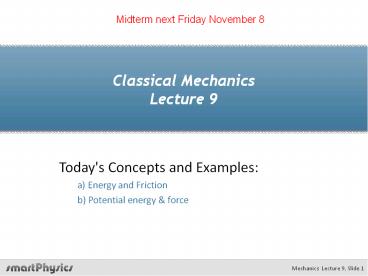Classical Mechanics Lecture 9 - PowerPoint PPT Presentation
1 / 43
Title:
Classical Mechanics Lecture 9
Description:
Title: Physics 211 Author: Mats Selen Last modified by: wayne springer Created Date: 1/4/2000 10:49:06 PM Document presentation format: On-screen Show (4:3) – PowerPoint PPT presentation
Number of Views:227
Avg rating:3.0/5.0
Title: Classical Mechanics Lecture 9
1
Classical Mechanics Lecture 9
Midterm next Friday November 8
- Today's Concepts and Examples
- a) Energy and Friction
- b) Potential energy force
2
Main Points
3
Main Points
4
(No Transcript)
5
Force from Potential Energy1D
6
Force from Potential Energy in 3-d
Gradient operator
7
Potential Energy vs. Force
8
Potential Energy vs. Force
9
Potential Energy vs. Force
10
Potential Energy vs. Force
11
Clicker Question
Suppose the potential energy of some object U as
a function of x looks like the plot shown below.
Where is the force on the object zero? A) (a)
B) (b) C) (c) D) (d)
12
Clicker Question
Suppose the potential energy of some object U as
a function of x looks like the plot shown below.
Where is the force on the object in the x
direction? A) To the left of (b) B) To the
right of (b) C) Nowhere
13
Clicker Question
Suppose the potential energy of some object U as
a function of x looks like the plot shown below.
Where is the force on the object biggest in the
x direction? A) (a) B) (b) C) (c) D)
(d)
14
Equilibrium
15
Equilibrium points
16
Equilibrium points
17
Equilibrium points
18
Block on Incline
19
Block on Incline
20
Block on Incline
21
Block on Incline
22
Energy Conservation Problems in general
For systems with only conservative forces acting
Emechanical is a constant
23
Gravitational Potential Energy
24
Gravitational Potential Problems
- conservation of mechanical energy can be used to
easily solve problems.
- Define coordinates where is U0?
as
- Add potential energy from each source.
25
Trip to the moon
26
Trip to the moon
Can ignore effect of moon for this problem at
level of precision for SmartPhysics
27
Trip to the moon
or you can practice solving the quadratic
equation with many terms!!!
28
Trip to the moon
Can NOT ignore effect of moon for this problem
since the rocket is AT the moon in the end !!!!
29
Trip to the moon
30
Trip to the moon
31
Trip to the moon
32
Block on Incline 2
33
Block on Incline 2
34
Block on Incline 2
35
Block on Incline 2
36
Checkpoint
A block of mass m, initially held at rest on a
frictionless ramp a vertical distance H above the
floor, slides down the ramp and onto a floor
where friction causes it to stop a distance r
from the bottom of the ramp. The coefficient of
kinetic friction between the box and the floor is
mk. What is the macroscopic work done on the
block by friction during this process? A) mgH B)
mgH C) mk mgD D) 0
m
H
D
Mechanics Lecture 9, Slide 36
37
Work by Friction Wfrictionlt0
Motionless box released on frictionless incline
which then slides on horizontal surface with
friction to a stop.
m
H
38
CheckPoint
What is the macroscopic work done on the block
by friction during this process? A) mgH B)
mgH C) mk mgD D) 0
B) All of the potential energy goes to kinetic as
it slides down the ramp, then the friction does
negative work to slow the box to stop
C) Since the floor has friction, the work done by
the block by friction is the normal force times
the coefficient of kinetic friction times the
distance.
m
H
D
39
Checkpoint
A block of mass m, initially held at rest on a
frictionless ramp a vertical distance H above the
floor, slides down the ramp and onto a floor
where friction causes it to stop a distance D
from the bottom of the ramp. The coefficient of
kinetic friction between the box and the floor is
mk. What is the total macroscopic work done on
the block by all forces during this process? A)
mgH B) mgH C) mk mgD D) 0
m
H
D
Mechanics Lecture 9, Slide 39
40
CheckPoint
What is the total macroscopic work done on the
block by all forces during this process? A)
mgH B) mgH C) mk mgD D) 0
B) work change in potential energy
C) The only work being done on the object is by
the friction force.
D) total work is equal to the change in kinetic
energy. since the box starts and ends at rest,
the change in kinetic energy is zero.
m
H
D
41
unit 8
Average 97.9
42
How much time did you spend on Homework 8
- 0-30 minutes
- 31-60 minutes
- 61-90 minutes
- 91-120 minutes
- More than 2 hours
43
Estimate your ability to do problems similar to
Unit 8 homeworkin an exam setting
- Excellent ability
- Very good ability
- Good ability
- Fair ability
- Poor ability
- Not sure































